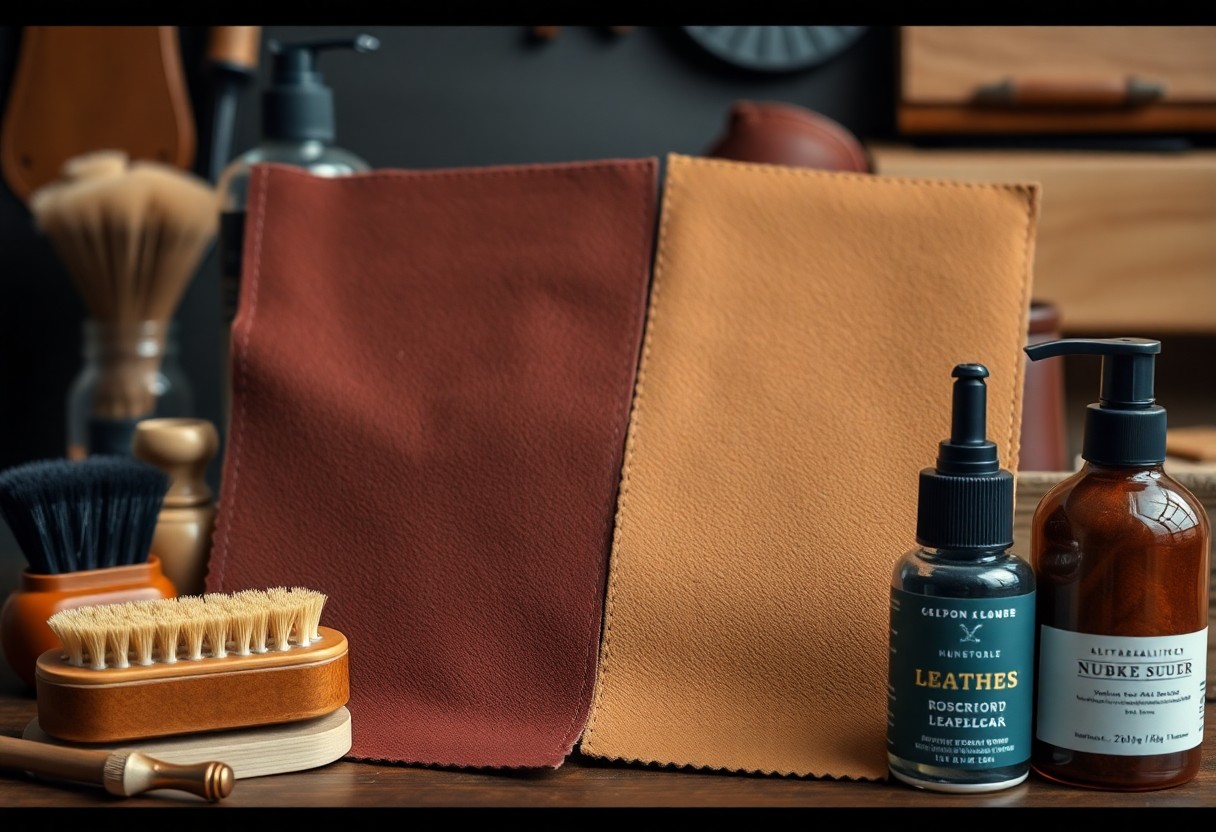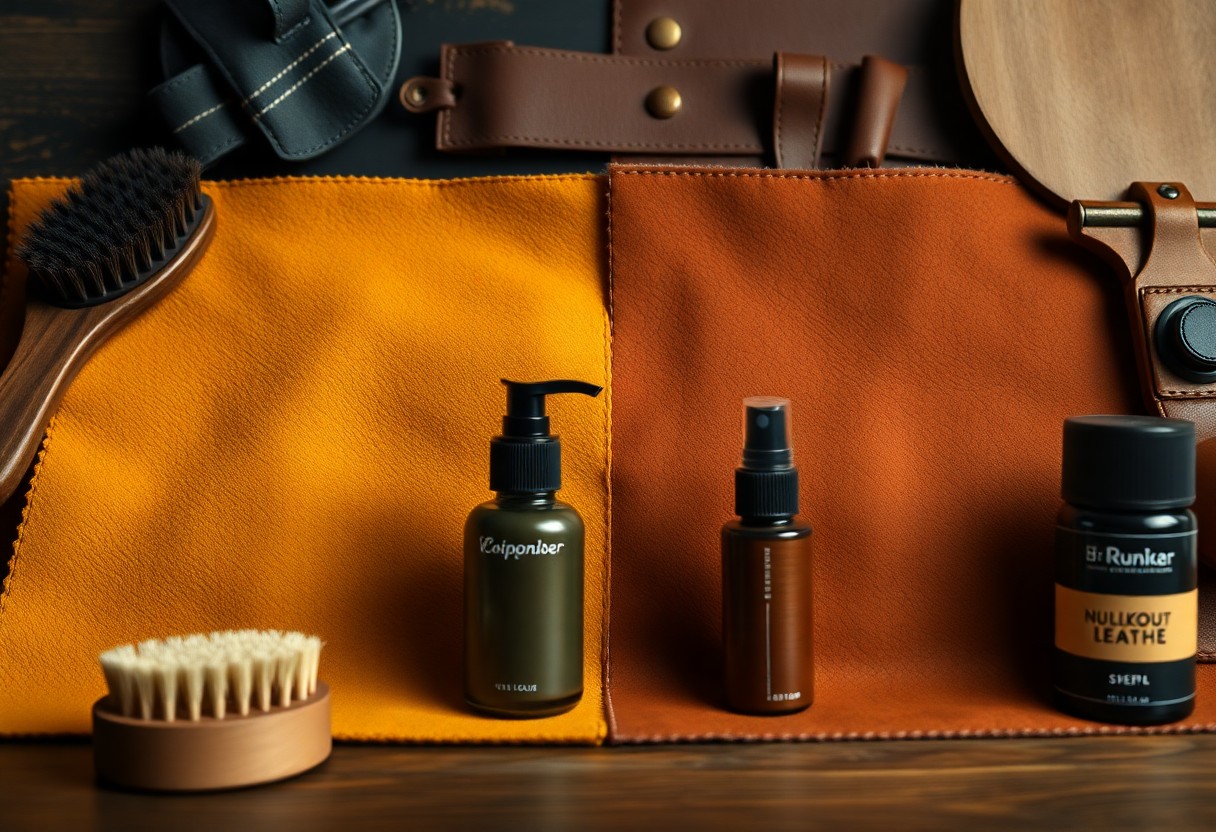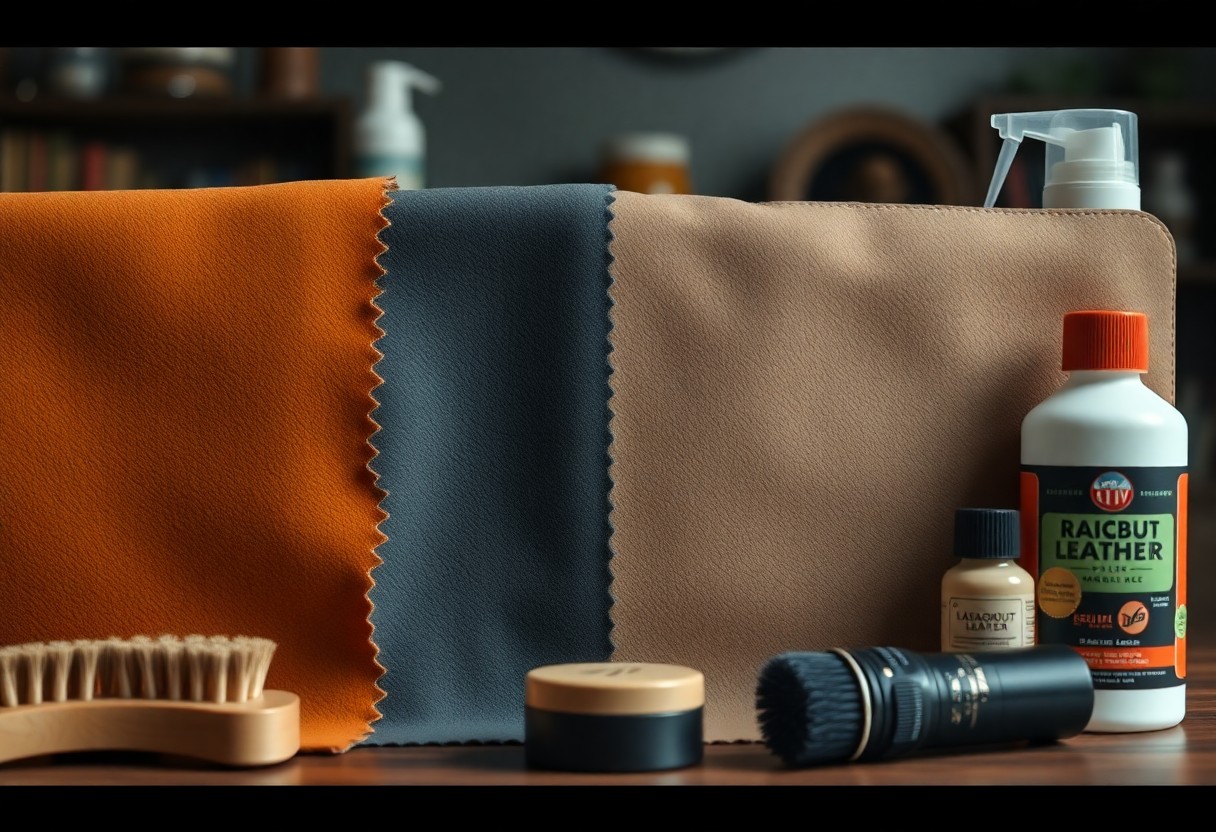Nubuck, suede, and roughout leather represent three unique varieties of leather, each with specific traits that greatly impact the durability and visual aesthetics of leather products. These materials are widely used in numerous items, from fashionable footwear to stylish outerwear, requiring distinct care techniques tailored to each type. Nubuck, known for its exceptional durability, is made from the top grain of the hide, making it an ideal choice for items subjected to rigorous use. In contrast, suede offers a softer, more luxurious sensation, making it suitable for contemporary fashion pieces. Roughout leather, characterized by its porous surface, is particularly vulnerable to water damage, necessitating additional protective measures. By comprehending these distinctions, you can make informed decisions about the appropriate leather type for your requirements and maintain its quality effectively. This comprehensive guide will assist you in identifying each leather type while providing best practices for their care and maintenance.

Explore the Unique Features and Benefits of Different Napped Leather Types
For leather aficionados and consumers, it is paramount to grasp the various napped leather types available in the market for making educated purchasing choices. These varieties encompass nubuck, split suede, full reverse suede, and roughout leather. Although they may look similar at first glance, each type comes with its own unique characteristics and intended applications. Gaining an understanding of these differences empowers you to select the most suitable leather that aligns with your individual needs and personal tastes, thereby enhancing your overall buying experience.
| Type | Key Features |
|---|---|
| Nubuck | Sanded grain surface, durable |
| Split Suede | Derived from corium layer, less durable |
| Full Reverse Suede | Reversed full grain leather, strong core |
| Roughout | Untreated corium surface, rugged texture |
| Care Requirements | Waterproofing necessary for all types |
Discover the Exceptional Durability of Nubuck Leather
While nubuck may visually resemble suede, it stands out by offering superior durability due to its unique grain leather structure. The surface is meticulously sanded to create a fine, velvety nap, significantly improving its resistance to wear compared to other napped leathers. This characteristic makes nubuck highly desirable for those seeking longevity in their leather items, especially in environments where frequent wear and tear are expected. Whether you are considering footwear, jackets, or accessories, the enduring quality of nubuck ensures that your investment remains intact over time, proving its worth for daily use.
Uncover the Versatile Qualities of Split Suede Leather
To truly appreciate split suede, it is essential to understand its origins, as it is crafted from the corium layer of animal hide. This leather type features loose fibers and a soft texture, inviting touch and comfort. However, it demands careful maintenance due to its porous nature. The characteristics of split suede can significantly vary based on the specific animal hide utilized and the processing methods applied, ranging from lightweight fashion suede to heavy-duty footwear suede. Each variant serves distinct roles in both fashion and functionality, making it imperative to choose wisely based on your intended use and style preferences.
Understand the Innovative Construction of Full Reverse Suede Leather
To fully grasp the concept of full reverse suede, it's important to recognize its innovative construction, which involves turning full-grain leather inside out. This unique approach creates a suede-like surface while preserving the structural integrity of the full-grain leather. This design not only ensures enhanced water resistance but also durability, making it a popular choice for premium footwear and leather goods that require both aesthetic appeal and functional reliability. Full reverse suede showcases unique attributes that provide a sophisticated appearance while ensuring long-lasting performance, appealing to discerning consumers.
Commonly found in high-end products, full reverse suede's exceptional qualities deliver an elegant look while guaranteeing resilience and functionality.
Explore the Distinctive Qualities of Roughout Leather
The standout features of roughout leather include its deliberately unrefined surface and remarkable durability. With its rugged texture, it sets itself apart from other napped leathers, appealing to those who favor a more robust aesthetic. Roughout leather retains the full hide structure, making it particularly suited for work boots and outdoor gear where resilience is paramount. As time passes, this leather type naturally ages, developing a unique patina that enhances its visual charm and character, making each piece distinct.

Make Informed Choices by Recognizing Key Differences Among Leather Types
Understanding the fundamental differences between nubuck, suede, and roughout leather is essential when assessing their construction and individual characteristics. Each type offers unique properties tailored to various applications and wear conditions. By comprehending these distinctions, you can make better-informed decisions regarding your leather products, ensuring you select the best options that align with your lifestyle and specific requirements, whether for daily wear or special occasions.
| Feature | Characteristics |
|---|---|
| Origin | Grain layer vs Corium layer |
| Surface | Fine vs Coarse nap |
| Durability | High to moderate resistance |
| Maintenance | Regular to intensive care |
| Applications | Footwear to accessories |
Conduct a Comparative Analysis of Material Structures in Napped Leathers
Next, let's delve into how these leather types differ in their fundamental structure:
| Leather Type | Structure |
|---|---|
| Nubuck | Sanded grain layer |
| Suede | Split corium layer |
| Roughout | Reversed full grain |
Analyze Surface Texture for Enhanced Understanding
To develop a clear understanding of the surface characteristics, it’s crucial to examine the nap length and texture of each leather type. Nubuck features the shortest and finest nap, leading to a smooth, soft feel, whereas roughout leather displays a more irregular, coarse texture that contributes to its rugged charm. The variations in texture significantly impact how each leather type responds to wear and treatment, ultimately affecting their care and longevity. Notably, suede forms a distinct patina over time, which adds character and charm to its appearance, while nubuck maintains a more consistent look throughout its lifespan, showcasing its durability and resilience.
Consider Key Durability Factors for Longevity
If durability is your primary concern, it’s essential to take into account several key factors that influence the longevity of leather items:
- Water resistance varies significantly across different leather types
- Wear patterns develop uniquely based on usage conditions
- Structural integrity is contingent upon the specific leather type and its treatment
Any damage to the surface necessitates tailored repair techniques to restore it effectively to its original condition.
Environmental factors also play a significant role in leather durability:
- UV exposure can impact color retention and fading
- Temperature fluctuations affect flexibility and comfort
- Moisture levels influence overall material stability and integrity
When selecting protective treatments, ensure they are compatible with your specific leather type to achieve optimal results without compromising quality.
Implement Essential Care and Maintenance Practices for Napped Leathers
Unlike smooth leathers, napped leathers require specific care techniques to preserve their unique texture and overall appearance. Your nubuck, suede, and roughout leather items demand regular brushing, protection from moisture, and careful cleaning to maintain their distinctive characteristics. These materials are more susceptible to staining and water damage compared to their smooth leather counterparts, underscoring the importance of adhering to proper maintenance routines to extend their lifespan and aesthetic appeal.
Utilize Effective Cleaning Methods for Napped Leather Items
To clean your napped leather items effectively, use a specialized suede brush and work in a single direction to gently eliminate surface dirt and debris. For more stubborn stains, a suede eraser can be an invaluable tool, and it’s recommended to avoid water-based cleaning methods whenever possible, as they can cause damage. For deeper cleaning requirements, apply products specifically formulated for your leather type, as traditional leather cleaners may adversely affect the nap and overall texture.
Adopt Protective Techniques for Napped Leather Longevity
To ensure the longevity of your napped leather, applying a high-quality water repellent spray is essential. Treat new items prior to their initial use and aim to reapply this protective barrier every 3-4 months. This practice creates a shield against moisture while allowing the leather to remain breathable and comfortable for long-term use.
Understanding appropriate protection methods is crucial for extending the lifespan of your leather products. Regular maintenance should include thorough inspections for wear spots, reapplying protective treatments after heavy use, and avoiding direct exposure to heat or sunlight. Tailor your protection regimen to match the frequency of use, increasing application intervals for everyday items that encounter more wear.
Follow Optimal Storage Recommendations for Napped Leather
When it comes to storing napped leather, attentive consideration of the environment is crucial. Ideally, keep your items in a cool, dry place that is shielded from direct sunlight. For footwear, utilizing shoe trees can help maintain their shape, while stuffing bags with paper provides additional support. Avoid storing leather items in plastic bags, as they require air circulation to retain their quality and prevent moisture buildup.
For long-term storage, opt for breathable cloth bags, ensure adequate air circulation, and routinely check for moisture or mold. Aim for 40-50% humidity in the storage area to prevent the leather from drying out or developing mildew. Keep items separated to avoid color transfer and to maintain their individual shape and integrity.

Explore Practical Applications and Uses of Different Leather Types
Your selection of nubuck, suede, or roughout leather significantly influences the durability and aesthetic appeal of the final products. Each leather type serves distinct purposes based on its unique properties. For instance, nubuck is ideal for high-durability applications, while suede offers a softer, more flexible option for fashion items, showcasing its versatility across various contexts and styles.
Footwear Applications: Choosing the Right Leather Type
All three leather types can be utilized for footwear, yet each possesses specific strengths. Nubuck is particularly well-suited for outdoor and work boots due to its unmatched durability, while split suede is an ideal choice for dress shoes and casual sneakers. Roughout leather, with its rugged texture, is especially suitable for crafting high-performance hiking boots that effectively resist scuffs and abrasions, ensuring that your footwear stands up to the test of the elements.
Garment Manufacturing: Selecting the Ideal Leather for Clothing
The applications of these leathers in garment manufacturing vary significantly due to their unique characteristics. Suede is particularly well-suited for fashionable jackets, while roughout leather is preferred for durable workwear that can withstand the rigors of daily use. Although nubuck is less frequently utilized in clothing, it serves as an excellent choice for protective panels in motorcycle gear, offering both style and safety.
For example, split suede is often used in lightweight jackets and vests, while roughout leather is favored in heavy-duty work shirts and pants. The choice of material typically aligns with the intended purpose of the garment—soft suedes are common in trendy fashion items, while protective gear benefits from the sturdiness and resilience of nubuck or roughout options, ensuring long-lasting wear.
Accessory Creation: Utilizing Leather Types for Unique Designs
These leather types play a vital role in crafting an array of accessories. Nubuck is perfect for creating stylish watch straps and belts, while suede is well-suited for attractive bags and wallets that combine functionality with aesthetic appeal. Roughout leather stands out in the realm of durable outdoor gear, such as backpacks designed to endure rugged environments and challenging conditions.
With thoughtful material selection, you can create accessories that perfectly align with their intended purposes, ensuring both style and practicality. Split suede works best for decorative items, while nubuck and roughout excel in products requiring high wear resistance. Always consider potential water exposure and environmental factors when choosing the appropriate leather type for outdoor accessories.
Understand the Factors That Influence Leather Quality
Recognizing that the quality of napped leather is shaped by several essential factors is crucial. These include hide selection, tanning processes, and manufacturing techniques. The durability and appearance of the finished product are significantly influenced by these key considerations, making it vital to understand how they come together to create high-quality leather.
Recognize the Importance of Hide Selection for Quality Leather
To ensure optimal quality, it’s essential to understand that premium hides originate from animals raised under ideal conditions. These hides exhibit fewer surface defects and a more uniform fiber structure. The quality of your leather begins with selecting hides that show minimal scarring and possess an appropriate thickness, profoundly impacting the final product's integrity and appearance.
Understand the Influence of Tanning Processes on Leather Characteristics
The tanning process, whether it involves vegetable or chrome tanning, plays a significant role in determining the ultimate quality of the leather. Each method imparts unique characteristics regarding water resistance, flexibility, and color absorption. This critical phase necessitates meticulous control over temperature, pH levels, and chemical concentrations, as the durability and texture of your leather are directly influenced by these carefully managed conditions throughout the extensive 4-6 week tanning period.
Explore Manufacturing Techniques That Shape Leather Quality
In producing napped leather, specialized buffing techniques are employed to create the distinctive surface texture. The final appearance of your leather is greatly influenced by the depth of buffing and fiber exposure during this process. A consistent manufacturing approach is vital to ensure uniform nap height and direction, as these elements are directly linked to the leather’s wear resistance and overall aesthetic appeal, contributing to the product's quality and longevity.
Conduct a Comprehensive Analysis of the Pros and Cons of Napped Leather Types
Each type of napped leather offers unique characteristics that render it suitable for various applications. Your decision between nubuck, suede, and roughout leather should be based on your specific needs and intended use, ensuring you select the most appropriate option for your situation and personal style preferences.
| Pros | Cons |
|---|---|
| Unique aesthetic appeal | Requires regular maintenance |
| Soft, comfortable texture | More susceptible to water damage |
| Good breathability | Shows wear marks easily |
| Various color options | Needs special cleaning products |
| Versatile applications | Higher maintenance costs |
Examine the Advantages of Each Napped Leather Type
Every type of napped leather offers specific advantages tailored to meet different needs. Nubuck provides superior durability due to its dense grain structure, making it ideal for high-use items. Conversely, suede offers excellent flexibility and softness, perfect for fashionable designs that require both style and comfort. Meanwhile, roughout leather combines distinctive texture with strength, making it a versatile choice for a range of applications, from workwear to outdoor gear.
Identify Limitations and Considerations for Napped Leather Use
Despite their unique features, each leather type has its limitations that should be considered. Water exposure can seriously compromise untreated napped leathers, and regular maintenance is necessary to uphold their appearance and integrity over time. Your choice should reflect your intended usage: indoor applications are generally less risky than outdoor scenarios, and factors such as climate and frequency of wear can significantly influence the leather’s durability and performance.
Ultimately, your comprehensive understanding of nubuck, suede, and roughout leather equips you to make informed choices for your leather goods. You can now identify the critical differences among these leather types based on their construction, durability, and care requirements. By implementing the appropriate care methods for each type—such as utilizing waterproof sprays for nubuck, gentle brushing for suede, and tailored treatments for roughout leather—you can significantly extend the life of your leather items. This knowledge empowers you to select the best leather type for your specific needs while maintaining its quality for years to come.
Address Common Questions About Napped Leather
What are the key differences between nubuck and suede leather?
Nubuck is crafted from the grain layer of leather, which undergoes light sanding on the surface, resulting in superior durability and water resistance. Conversely, suede is derived from the softer bottom layer (corium) of the hide, making it more porous and less resilient. Additionally, nubuck features a shorter and finer nap compared to the longer, softer texture of suede, which affects their overall feel and maintenance requirements.
What are the best practices for protecting and cleaning napped leathers?
For optimal care, apply a waterproof spray to all napped leathers before initial use. Clean them using a specialized suede brush to effectively remove dirt and revive the nap. For stains, utilize dedicated suede or nubuck cleaning solutions. Avoid exposing these leathers to heavy rain, and allow damp leather to dry naturally at room temperature. After drying, brush the leather to restore its nap and ensure a polished appearance.
What distinguishes roughout leather from reverse suede?
Roughout leather retains the untreated and rough corium layer, while reverse suede has this layer sanded smooth, creating a softer finish. Both leather types feature the grain layer facing inward, enhancing their durability compared to split suede. However, roughout presents a more textured and uneven surface compared to reverse suede’s uniform nap. Both types are suitable for unlined shoes due to the smoothness of their flesh sides, providing comfort and support.
The Article Guide to nubuck suede and roughout leather differences care tips and uses appeared first on My Shoes Finder
Categories:
Tags:
Comments are closed